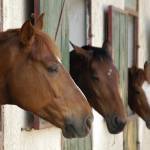Mad Cow Disease Not Cause for Equine Concern

There is no such thing as mad horse disease, at least not yet. It is possible that such a disease could occur in the future, however. As scientists learn more about mad cow disease, chronic wasting syndrome, and other ailments known as prion diseases, they are examining and changing some of the long-accepted beliefs about the origin and transmission of illness.
What are prions?
A prion is defined as a particle of protein that lacks DNA and has the ability to impart and propagate conformational variability.
And that means…what?
DNA contains the pattern that allows cells to replicate. As a cell prepares to divide, its nucleus splits into two identical halves, each containing a complete set of instructions for its form and function. Thus one cell becomes two cells, each of which may divide to form more cells of the same type. This is the normal pattern by which tissues grow.
Prions, lacking DNA, take a different path to make many copies from one original. Their premise seems to be, “If I can’t reproduce myself, I’ll convince all the others to change so they will look just like me.” Instead of the normal spiral formation of amino acids that make up most proteins, disease-causing prions develop flattened areas within the spirals, changing their conformation or shape. These deformed prions are designated
PrPsc, while normal prions are labeled PrP. PrPsc prions have the amazing ability to cause other prions to assume the same disrupted shape and to clump together, playing havoc with their ability to function. This leads to the death of brain cells with which the prions are associated. Early signs of disease include incoordination and behavioral changes. As cell death continues, the brain becomes riddled with holes. This sponge like appearance of the diseased brain suggested the alternate name for these conditions: transmissible spongiform encephalopathies.
Are there other differences between prions and disease-causing particles?
The tendency for prions to deform can be passed from parents to their offspring, making prion disease an inherited condition. In a few cases the tendency is not inherited but occurs because a normal prion spontaneously begins to flatten and fold. The third way an animal or human can develop prion disease is by ingestion of contaminated tissue, as when animal protein is included in feed products, or possibly by contact with body fluids. Prion diseases are therefore unique in that they can be inherited, caused by mutation, or picked up from a diseased individual.
Prions are incredibly resistant to digestive enzymes and also to radiation and heat, two sterilization methods that are effective against viruses and other common disease vectors. Prions also have the ability to adhere tightly to plastic or metal implements and machinery. These factors have made the decontamination of butchering and meat processing equipment extremely difficult.
What are the major prion diseases?
Probably the most publicized prion disease is mad cow disease or bovine spongiform encephalopathy (BSE), which caused the slaughter of hundreds of thousands of cattle in Great Britain. While it has not been proven, it is strongly suspected that human consumption of meat from infected cattle led to over 100 cases of a fatal brain-destroying disease known as new-variant Creutzfeldt-Jakob disease (nvCJD). This strain, which victimized individuals under 30 years old, differed from classic CJD which develops much more slowly and targets middle-aged people.
Sheep are susceptible to a prion disease called scrapie. Deer and elk have been diagnosed with a neurologic disease called chronic wasting syndrome. Mink farms have been struck with a similar malady, and a few cases of feline neurologic illness have also been identified as prion disease.
Are these diseases likely to spread to horses?
At the present time there is no evidence that horses are susceptible to any prion diseases, and transmission to equines from infected cows, deer, or other species has not been noted. Some scientists, however, warn that many mammals are susceptible, at least under laboratory conditions, where infection has been experimentally introduced into pigs, monkeys, and other species.
A worrisome finding is that some species may be able to carry and spread prion diseases without becoming ill themselves. In one study, tissue from scrapie-infected hamsters was injected into mice. The mice did not develop signs of disease, but when tissue from the mice was injected into healthy hamsters, the hamsters developed scrapie. While it is not impossible that horses could play a part in this type of disease transmission, there is no suspicion that this is the case.
A hopeful sign is that some strains of sheep seem to be highly resistant to scrapie, while other types are much more susceptible to infection. It may turn out that horses have a similar type of genetic protection against prion disease.
Can prion diseases be treated or cured?
While some medical treatments show promise, there is as yet no effective medication to cure mad cow disease, scrapie, or chronic wasting syndrome. All known prion diseases are invariably fatal.
What do horse owners need to know about prion diseases?
While horses do not appear to be in danger from known prion diseases, there is no guarantee that this type of illness will never be a threat to equines. The study of prion diseases is in its infancy, and the list of questions is much longer than the list of established facts. Many of the conclusions and explanations are “best fit” theories that are still being tested. As research continues, concerned horse owners can try to stay abreast of the latest findings. Owners should also pay close attention to a horse’s coordination and behavior, and notify a veterinarian if significant changes are observed.








